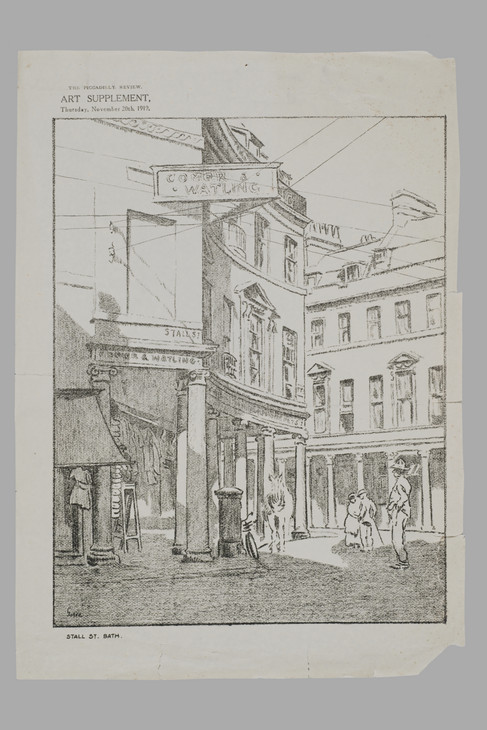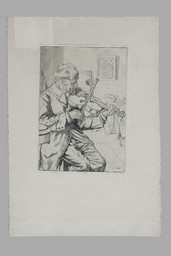Sylvia Gosse Stall Street, Bath 1919

Sylvia Gosse 1881–1968
Stall Street, Bath 1919
Lithograph 300 x 231 mm on paper 370 x 257 mm
Inscribed by the artist 'Gosse' bottom left
Tate Archive TGA 8120/6/3
© Estate of Sylvia Gosse / The Bridgeman Art Library
Sylvia Gosse 1881–1968
Stall Street, Bath 1919
Lithograph 300 x 231 mm on paper 370 x 257 mm
Inscribed by the artist 'Gosse' bottom left
Tate Archive TGA 8120/6/3
© Estate of Sylvia Gosse / The Bridgeman Art Library
In 1908 Sylvia Gosse began studying engraving after meeting Walter Sickert. She was taught by him first at the Westminster School of Art and then at his new art school at 209 Hampstead Road (later moving to number 140, see Tate N05088). She began teaching at the school in 1910 when she also became an associate (it was renamed the ‘Sickert and Gosse School of Painting and Etching’). In 1926 she was elected a member of the Royal Society of Painter-Etchers and Engravers. There are collections of her prints and drawings in the British Museum, London and the Ashmolean Museum, Oxford.
This lithograph was published in the Art Supplement of the Piccadilly Review on 20 November 1919. It depicts the premises of Comer & Watling drapers at 35–6 Stall Street at the junction with Bath Street. Alongside the classical ionic columns can be seen three figures, a horse and a pillar box with a bicycle leaning against it; clothes hang outside the shop with a figure on a ladder probably adding more. Above, the sign for Comer & Watling juts out from the building and telephone wires bisect the picture.
Stall Street was designed by the architects Thomas Baldwin and John Palmer and completed in the late eighteenth and early nineteenth centuries. Gosse depicts the drapers rather than the south colonnade of the Grand Pump Room, which is on the opposite side of the road. 35–6 Stall Street is a listed building so the view remains much the same today.
Sickert first visited Bath in 1917 where his home was The Lodge, Entry Hill with a studio in town at 10 Bladud Buildings, close to Stall Street. There he painted many street views such as Belvedere, Bath c.1917 (Tate N05087). He spent his summers in Bath until 1919 when, following the end of the war, he was again able to cross the Channel to stay in France. Gosse most probably made the drawing for this lithograph while visiting Sickert in 1919.
How to cite
Sylvia Gosse, Stall Street, Bath, 1919, in Helena Bonett, Ysanne Holt, Jennifer Mundy (eds.), The Camden Town Group in Context, Tate Research Publication, May 2012, https://www

